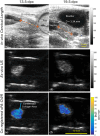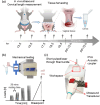Multi-parametric quantitative evaluation of murine cervical remodeling during pregnancy and postpartum
- PMID: 40348833
- PMCID: PMC12065793
- DOI: 10.1038/s41598-025-98765-8
Multi-parametric quantitative evaluation of murine cervical remodeling during pregnancy and postpartum
Abstract
Cervical remodeling during pregnancy is a critical process that, if untimely, can lead to complications such as preterm birth (PTB). This study introduces a novel multi-parametric approach combining non-invasive imaging modalities to quantify cervical tissue changes during pregnancy and postpartum in a murine model. By integrating ultrasound-based measurements of cervical length, photoacoustic imaging of the collagen-to-water ratio, and elastography for tissue elasticity alongside histological assessments, this method provides a comprehensive evaluation of cervical remodeling. The findings reveal that combining these parameters significantly improves the accuracy of gestational age prediction compared to individual measurements, with a tri-parametric model achieving 85.3% prediction accuracy compared to 65.4% accuracy with histological analysis alone. This approach not only enhances the understanding of cervical remodeling but also holds potential as a minimally invasive, point-of-care diagnostic tool for early detection of cervical ripening and PTB risk. Ultimately, these advancements could inform clinical strategies for pregnancy management and labor induction, improving maternal and neonatal outcomes.
Keywords: Biomarkers; Cervical remodeling; Elasticity; Gestational age; Non-invasive; Photoacoustic; Ultrasound.
© 2025. The Author(s).
Conflict of interest statement
Competing interests: The authors declare no competing interests.
Figures



Similar articles
-
In Vivo Evaluation of Cervical Stiffness Evolution during Induced Ripening Using Shear Wave Elastography, Histology and 2 Photon Excitation Microscopy: Insight from an Animal Model.PLoS One. 2015 Aug 28;10(8):e0133377. doi: 10.1371/journal.pone.0133377. eCollection 2015. PLoS One. 2015. PMID: 26317774 Free PMC article.
-
Quantitative cervical elastography in pregnancy.Ultrasound Obstet Gynecol. 2013 Jun;41(6):712. doi: 10.1002/uog.12474. Ultrasound Obstet Gynecol. 2013. PMID: 23712888 No abstract available.
-
Quantitative cervical elastography in pregnancy.Ultrasound Obstet Gynecol. 2012 Nov;40(5):612; author reply 612-3. doi: 10.1002/uog.12320. Ultrasound Obstet Gynecol. 2012. PMID: 23168975 No abstract available.
-
The role of noninvasive diagnostic imaging in monitoring pregnancy and detecting patients at risk for preterm birth: a review of quantitative approaches.J Matern Fetal Neonatal Med. 2022 Feb;35(3):568-591. doi: 10.1080/14767058.2020.1722099. Epub 2020 Feb 23. J Matern Fetal Neonatal Med. 2022. PMID: 32089024 Review.
-
Cervical assessment by ultrasound for preventing preterm delivery.Cochrane Database Syst Rev. 2019 Sep 25;9(9):CD007235. doi: 10.1002/14651858.CD007235.pub4. Cochrane Database Syst Rev. 2019. PMID: 31553800 Free PMC article.
References
-
- Lamont, R. F. et al. Commentary on a combined approach to the problem of developing biomarkers for the prediction of spontaneous preterm labor that leads to preterm birth, (in English). Placenta98, 13–23. 10.1016/j.placenta.2020.05.007 (2020). - PubMed

